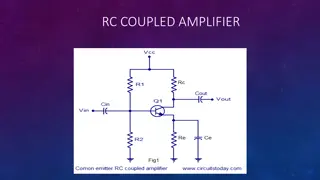Understanding Feedback Amplifiers in Electronic Circuits
Feedback amplifiers play a crucial role in electronic circuits by providing mechanisms for controlling gain, stability, and overall performance. There are two basic types of feedback - positive and negative, each offering distinct advantages. The four ways of connecting feedback signals involve voltage and current in series or parallel configurations, impacting parameters like input impedance, output impedance, frequency response, and noise levels. Gain with feedback is reduced compared to without feedback, leading to improved circuit performance. Various configurations like voltage-series, voltage-shunt, current-series, and current-shunt feedback offer different gain characteristics. Overall, feedback amplifiers offer a way to enhance circuit functionality and performance.
Download Presentation

Please find below an Image/Link to download the presentation.
The content on the website is provided AS IS for your information and personal use only. It may not be sold, licensed, or shared on other websites without obtaining consent from the author. Download presentation by click this link. If you encounter any issues during the download, it is possible that the publisher has removed the file from their server.
E N D
Presentation Transcript
Feedback Amplifiers Feedback Concepts: A typical feedback connection is shown in Fig.1. The input signal ,VS ,is applied to a mixer network, where it is combined with a feedback signal, Vf. The difference of these signals, Vi, is then the input voltage to the amplifier. A portion of the amplifier output (sampled signal), Vo, is connected to the feedback network ( ), which provides a reduced portion of the output as feedback signal to the input mixer network. There are two basic types of feedback in amplifiers positive feedback and negative feedback. When the feedback energy (voltage or current) is in phase with the input signal and thus aids it, it is called positive feedback. Both amplifier and feedback network introduce a phase shift of 180 . The result is a 360 phase shift around the loop, When the feedback energy (voltage or current) is out of phase with the input signal and thus opposes it, it is called negativefeedback the amplifier introduces a phase shift of 180 into the circuit while the feedback network is so designed that it introduces no phase shiftif the feedback signal is of opposite polarity to the input signal, as shown in Fig.1, negative feedback results. While negative feedback results in reduced overall voltage gain, a number of improvements are obtained, among them being:
1. Higher input impedance. 2. Lower output impedance. 3. Better stabilized voltage gain. 4. Improved frequency response. 5. Reduced noise. 6. More linear operation. Feedback Connection Types: There are four basic ways of connecting the feedback signal. Both voltage and current can be fed back to the input either in series or parallel. Specifically, there can be: 1. Voltage-series feedback (Fig.2a). 2. Voltage-shunt feedback (Fig.2b). 3. Current-series feedback (Fig.2c). 4. Current-shunt feedback (Fig.2d). Fig.1
Gain With Feedback: The gain without feedback, A, is that of the amplifier stage. With feedback, , the Overall gain of the circuit is reduced by a factor (1 + A), as detailed below. A summary of the gain, feedback factor, and gain with feedback of Fig. 2 is provided for reference in Table 1. Table 1 Feedback Types Parameters Voltage-series Voltage- shunt Current-series Current- shunt Gain without feedback A Feedback Gain with feedback Af
Voltage-Series Feedback: From Fig. 2a and Table 1; The gain with feedback is: Voltage-Shunt Feedback: From Fig. 2b and Table 1; The gain with feedback is:
Current-Series Feedback: From Fig. 2c and Table 1; The gain with feedback is: Current-Shunt Feedback: From Fig.2d and Table 1 The gain with feedback is:
Series Feedback: From Fig.3 with voltage-series feedback; Fig.3
Shunt Feedback: From Fig.4 with voltage-shunt feedback; Fig.4
Voltage Feedback: For the voltage-series feedback circuit of Fig.3, the output impedance is determined by applying a voltage, V, resulting in a current, I, with Vs shorted out (Vs = 0). The voltage V is then Current Feedback: From Fig.5 with current-series feedback; Fig.5
A summary of the effect of feedback on input and output impedance is provided in Table 2
Gain Stability (Sensitivity and Desensitivity) with Feedback: The fractional change in amplification with feedback divided by the fractional change without feedback is called the sensitivity of the gain. If the equation Af= A/(1+ A) is differentiated with respect to A, the absolute value of resulting equation is: Bandwidth with Feedback: Fig. 6 shows that the amplifier with negative feedback has more bandwidth ( f ) than the amplifier without feedback( ). The feedback amplifier has a higher upper 3-dB frequency and smaller lower 3-dB frequency. Fig.6
Method of Analysis of a Feedback Amplifier: To find the input circuit: 1. Set Vo = 0 for voltage feedback (sampling). In other words, short the output node. 2. Set Io = 0 for current feedback (sampling). In other words, open the output loop. To find the output circuit: 1. Set Vi = 0 for shunt feedback. In other words, short the input node. 2. Set Ii = 0 for series feedback. In other words, open the input loop. Table 3 summarizes the above procedure and should be referred to when
H.W:- Calculate Avf , Zif ,and Zof for the amplifier circuit shown , given : gm = 1mv , rd = 20k H.W :- Calculate Avf , Zif ,and Zof for the amplifier circuit ,Assume hfe = 50, hie = 1.1k , and identical transistors?























